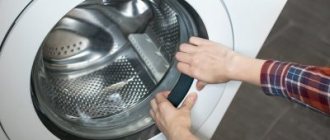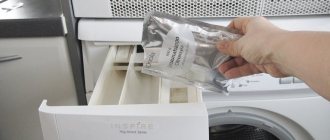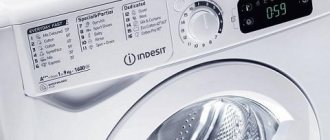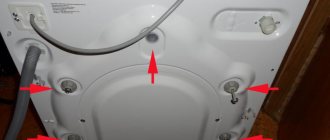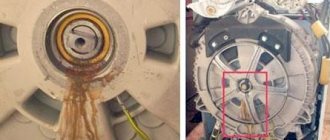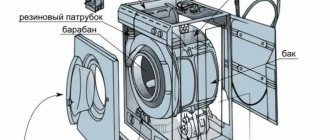If the drum in the washing machine does not spin, you need to take immediate action. There may be several reasons for this malfunction. To find them, you need to find out at what stage the washing machine broke down: when starting with laundry or during the spin stage.
Let's look at how to identify signs of a malfunction and perform repairs yourself.
The drum does not spin when washing
Why doesn't the drum rotate when washing? Here are the main reasons:
- Imbalance.
- Problems with the drive belt.
- Failure of the heating element.
- Motor malfunction (brush wear).
- Problems with the tachometer (motor speed controller).
- The electronic module has burned out.
- Wiring fault.
- Entry of a foreign object.
There are many reasons: how to figure out what happened in your case and what needs to be done with the washing machine, read below.
Diagnostics in case of malfunction
Modern Samsung washing equipment is a complex and sensitive technology that responds even to minor faults and interference. The display is a good help in determining the type of failure.
Eg:
- If it is impossible to drain due to a clogged drain pipe, filter, or hose, the washing machine reports a malfunction using one of the codes - 5C, , SE, E.
- If there are problems with the motor brushes or belt, as well as in case of overload and failure of the electronic board, one of the codes may be issued - UB, , E.
- Unstable voltage in the network, failure in the control board - UC, 9C, 9E1, 9E.
It is impossible to accurately diagnose a breakdown just by the type of code, since each coding covers a wide range of malfunctions in the operation of various components.
Doesn't spin when spinning
The automatic washing machine carried out the wash normally, but the drum does not spin during the spin cycle. Why does this happen? Here are some reasons:
- The “No spin” program is turned on, or the delicate wash mode has been selected. In this case, the laundry is wrung out minimally or not at all.
- If there is a blockage in the drain system, the water does not drain after washing, and the spin cycle cannot begin.
- An imbalance has occurred. The load of laundry has been exceeded, which has led to imbalance. Things got to one side and work stopped.
- The pressure switch, which sends information to the main module about the amount of water in the tank, is faulty. If there is no command, the spin will not start.
- Problems with the control board. The wiring may have burned out or the control triac has burned out.
A similar malfunction can happen with any brand of washing machine: Indesit, Ariston, Bosch, Zanussi and others. It is necessary to react in time and fix the problem.
Preventive measures to help avoid breakdowns
To prevent malfunctions of washing machines during their operation, you should always follow the following rules:
- Be sure to read the operating instructions and fully adhere to everything written in it.
- Do not overload the drum.
- Do not machine wash large items that could damage the tank.
- Before putting things into the drum, be sure to check all pockets for the presence of small third-party objects (changes, keys, etc.).
- Be sure to thoroughly clean your washing machine. This activity must be performed at least once a year. To clean, fill in a special cleaner and run the machine without laundry, selecting the program with the highest temperature setting.
- Use special bags for washing small items of clothing and women's underwear.
- Monitor the technical condition of the automatic machine.
- Correct minor faults in a timely manner.
If during operation of the washing machine there are power outages and power surges, it is necessary to stop the washing process and turn off the power to the equipment.
In case of constant power surges, it is recommended to use special stabilizers, otherwise there is a risk of complete failure of the washing machine without the possibility of further restoration of its functionality.
To maximize the service life of your washing equipment, you must always keep it clean. You should also monitor the condition of the main controls. For example, all keys should be pressed without effort. You should periodically clean the washing machine control panel from dirt and grease.
After completing the wash, be sure to drain the remaining soapy water through the outlet filter (if so provided by the design). After completing the wash, you need to wipe the drum dry and turn off the power to the machine.
The machine does not turn, but takes in water
Why does the machine take in water, but the drum does not rotate? Immediately drain the water and try turning the drum by hand. If it doesn't turn by hand, it's probably jammed.
For what reasons did the problem occur:
- The drive belt has broken or fallen off and is wrapped around the pulley. This was the reason for the jamming.
- An object is stuck between the tank and drum. It could be any items that fell out of the pockets.
- The drum bearing has deteriorated, so it cannot rotate normally.
In most cases, bearings fail due to prolonged use, overloading of the drum, or if the seal has never been lubricated.
Additional reasons for the drum not working
If the tank in an automatic machine does not work or it stops rotating for a while, this can be caused by various equipment malfunctions. According to experienced craftsmen, the device stops washing if there is a blockage in it, localized in the filter for draining dirty water. Therefore, if the washing machine’s tank stops spinning, you need to first check the condition of the filter. Typically, many modern units have instructions on how to properly clean them. It is not difficult to find - the filter is located in the corner of the device. In order not to “say goodbye” to the machine, it is necessary to regularly clean it of hair, threads, lint, husks and other debris - only after this the washing will be safe and of high quality.
Also, if the washing machine is “visited” by a lack of drum rotation, this often occurs when the integrity of the wiring is damaged. In this case, rotate the tank - when twisted manually, it will give way, and when connecting the equipment to the power supply, it will stop spinning on its own. To accurately check for faulty or burnt wiring, you should turn it carefully and carefully. In addition, when this violation occurs, all lights and lights will stop lighting up.
In any case, if the drum stops spinning, you should call a technician who will carry out a series of diagnostic measures and understand why the tank stopped spinning and how to fix it.
If household appliances were washing normally and suddenly stopped functioning, burnt-out parts may be to blame. In this case, you need to check the machine for the integrity of the drum, and if the reason is not in it, it means that the components of the washing machine have stopped functioning normally.
The washing machine hums, but does not spin
You start the program, the washing machine begins to hum, as if drawing water, but the drum does not turn. Let's look at why this happens:
- If the engine breaks down. Perhaps the brushes are worn out, the lamellas are worn out, or a short circuit has occurred. This can only be checked by inspecting the engine.
- When the bearing is jammed.
CM does not work, the drum does not spin
The washing machine may not work at all for the following reasons:
- Electronic module malfunction. As a result, the engine does not receive the command to start working.
- Failure of the heating element. If the heater breaks down, the machine may not only wash in cold water, but may not work at all. Why does this happen? If scale forms and overheats, the heating element may explode and block the operation of the MAS.
SM works, but does not turn
If you don’t know why the washing machine works but the drum doesn’t spin, here are a few reasons:
- The washing machine has filled with water, but the drum does not rotate. Most likely, the heating element has burned out.
- Malfunction of the triac on the module, which is responsible for engine operation. In this case, the program starts, but the motor does not receive commands to rotate. The electric brushes could also burn out.
Why does the drum jam?
Physically blocking the rotation of the drum can be not only a blockage or a foreign object accidentally falling inside. Other factors that may cause the problem require professional repairs and replacement of worn-out parts.
What causes drum stupor:
- Overloading the tank or getting things into the opening between the flaps leads to the fact that the flaps begin to cling to the heating element. As a result, the machine does not spin the drum even when cranked by hand. The breakdown is not classified as complex, but repairs will require disassembling the washing machine and, if necessary, replacing the damaged part.
- If the machine stops spinning normally and when you turn it on you hear a loud noise or a grinding sound on metal, the reason lies in a rusted bearing. The part must be urgently replaced, and the device must be temporarily stopped in use. A worn bearing under pressure will break and scatter throughout the machine, which will complicate repairs by an order of magnitude.
- Worn seal. Theoretically, it is possible to replace it with your own resources. You will need to sequentially unscrew a couple of parts of the machine with a screwdriver, and then return them to their original places.
- A burnt-out heating element is one of the most dangerous breakdowns. It is difficult to recognize the problem in time, but if the part is not replaced, it shatters into small pieces that begin to block the rotation of the drum. Repair will require a lot of effort to remove fragments and replace the burst heating element.
Older models of washing machines are equipped with a capacitor part. A sign of a breakdown is that the device also does not spin the drum. In order for the washer to continue to serve, you will have to install a new capacitor.
Machines with vertical loading of laundry can “stand up” due to the opening of the doors. Although they are secured with a reliable lock, over time the part becomes loose and no longer holds the stop. A child who manages to turn the drum while the doors are open can contribute to the problem. If you wash clothes in this condition, the metal blades will ruin everything during the spin cycle. The matter is not limited to damage to clothes. Opened doors, spun to high speeds, break through the protective barrier, damaging the heating element and the laundry tub itself.
How to fix the situation
What should I do to troubleshoot? Let's look at the problems and their solutions.
Imbalance
To correct the imbalance, you need to stop the program. If there is water in the tank, it must be drained. To do this, unscrew the drain filter - it is located behind the hatch under the front panel. Read more about how to do this below.
Now open the hatch door and distribute the laundry evenly throughout the drum.
Blockage in the system
To clear a clog in the drain filter, proceed as follows:
- On the front panel below, open the small hatch by releasing the latches.
- Unscrew the filter, drain the water into a container and clean the filter from debris.
- Reinstall the part.
Belt problems
In order to check the drive belt, you need to remove the rear panel of the CM. Proceed sequentially:
- Remove the plug from the socket, turning off the power to the machine.
- Turn off the water supply and disconnect the intake hose (be careful, there may be water in it).
- Take a screwdriver and unscrew the screws on the back cover.
- After removing the panel, inspect the belt. If it frays or falls off, it needs to be put back in place. In case of wear, a new element is put on.
- First put the belt on the small pulley of the electric motor, then, while simultaneously turning the drum pulley, put the belt on it.
- Installation is complete, screw the panel into place.
Heating element malfunction, foreign object
These two problems can be resolved simultaneously:
- Remove the back cover as described above. In some models, the heating element is located behind the front panel: Samsung, Bosch, Siemens.
- There is a heating element under the tank. To check it, you need to connect a multimeter to the contacts and measure the resistance.
- When you are convinced of the malfunction, disconnect the wires from the heater.
- Unscrew the central nut (not all the way) and push the bolt inward.
- Prying the edges, pull the element out.
- Now you can check through the hole to see if there is a foreign object inside and remove it.
- Install the new heating element in reverse order.
Engine problems
You don't have to put the panel back in place since the motor is also at the back. Inspect its wiring for damage.
Then you need to remove the engine to inspect the brushes and other parts.
- Disconnect the motor wires.
- Unscrew the mounting bolts.
- Pull out the motor and its brushes. If they are worn out, new parts need to be installed. The same applies to lamellas and windings. They are checked last, if everything is in order with the brushes.
- Inspect the tachogenerator. It is mounted on the engine housing. If faulty, replace.
The main module burned out
It is difficult to repair electronics yourself, but it is possible to inspect them for damage.
- Unscrew the two screws at the back and remove the top cover.
- Remove the powder dispenser tray by pressing the latch in the center.
- Unscrew the control panel mounting bolts.
- Unclamping the latches, remove the panel from the SMA body.
- Inspect the wiring for integrity. Unclench the clamps and, having disconnected the panel, inspect the control board.
- If burnt parts are visible on it, it means repair or replacement is required.
- You can replace the element. Reinstall the new module, connect the connectors, and secure the panel to the chassis.
All parts in the washing machine can be replaced independently, but not everyone can cope with their repair. If you are not confident in your abilities, contact the service center.
Possible causes of malfunction
In order to determine the reason for the washing machine drum stopping, you need to remove all the items from it and then try to spin it by hand. If the drum remains stationary, do not force it to turn, as this will only make the problem worse.
If you need to apply some force to turn the drum of the washing machine, and some extraneous noise is heard, it is possible that the reason for the stop was a foreign object that got into the tank. For example, it could be a torn button or accidentally forgotten change in your trouser pockets.
If the drum rotates freely, in this case the reasons for its stopping may be problems with the electronics, failure of the electric motor or drive belt. In addition, there are many different reasons that cause the washing machine drum to stop during operation.
Drum overload
This is observed with inexpensive washing machines, since they almost always do not have a sensor for monitoring drum loading. More expensive models notify the user of overload with a corresponding signal (sound or graphic information) and do not start until the weight of the laundry is correctly adjusted in accordance with the parameters set by the manufacturer.
In addition, the process of balancing the laundry in the drum may be disrupted when starting the washing process. To put it simply, all things are collected in one lump, after which the alignment is disturbed (for example, shirts and towels end up in the duvet cover).
This causes increased vibration, which the electronic control system of the machine positions as an error. As a result, the washing process stops and the drum stops.
Electric motor failure
This malfunction consists in the absence of the sound of a running engine after turning on the machine and selecting a washing program. Here are the main reasons for this breakdown:
- wear of graphite brushes;
- break in the electric motor winding;
- lack of contact between the triac and the motor in the electric motor control system;
- mechanical damage to the engine, which prevents its full functioning;
- failure of the engine protection system against voltage surges;
- an error in non-volatile memory that causes the drum to fail and stop during operation;
- violation of the integrity of electrical wiring;
- lack of power to the electric motor;
- failure of the triac in the power supply system to the electric motor terminals;
- malfunction of the power controller processor;
- other problems.
Diagnosis of faults and repair of the electric motor of a washing machine should only be trusted by an experienced service center specialist. Under no circumstances should you try to restore the operation of the electric motor yourself, since any incorrect actions will only aggravate the breakdown. It is quite possible that the malfunction is minor, for example, wear of the brushes.
Presence of a foreign object in the washing machine
One of the common reasons why the drum stops is the presence of small foreign objects between the drum and the washing machine tub. These can be any small items that the user has forgotten in his pockets, buttons that have accidentally come off, or small things that fall into the space between the drum and the tank through the rubber seals.
Their presence is accompanied by extraneous noise during operation of the washing machine.
Such objects can completely block the drum during operation, so they must be removed without fail. This should be done only after the washing machine has been completely de-energized.
The easiest way to get into the space between the tank and the drum is from the side of the heating element, which must first be dismantled to ensure full access.
If you cannot remove the source of the noise, you will have to completely disassemble the tank. This may pose some difficulties, since most budget washing machines are produced with non-separable tanks. In this case, you will have to use the services of a service center, since in order to completely eliminate the malfunction it will be necessary to saw the tank and then restore its integrity (sealing). If the foreign object is not removed, it may damage the tank or drum beyond the possibility of further repair.
Motor brush wear
In any electric motor, brushes are consumables that must be periodically replaced due to natural wear and tear. The spent brushes completely cease to perform their function: to provide the necessary contact to create an electromagnetic field, due to which the rotor rotates. During operation, they gradually wear out, resulting in reduced contact. If you have certain knowledge, tools and skills, you can replace the brushes yourself, completely eliminating the described malfunction.
In order to replace worn brushes, it is necessary to dismantle the electric motor. Next, the electric motor should be placed on the table so that the brush commutator is at the top. We disassemble the brush seats and remove the worn elements. For most budget washing machine models, finding suitable brushes for the electric motor is quite problematic. In this case, we recommend contacting the manufacturer’s specialized service center.
The drive belt is faulty or loose
If you can clearly hear the sound of a running electric motor, but the drum does not rotate, the reason for this may be the drive belt, which can weaken, fly off, or completely fail. To assess its condition, you need to remove the back cover of the washing machine. There is one caveat here for certain models: in order to remove the back cover, you will need to unscrew the top one.
Let's move on to inspecting the condition of the drive belt. The presence of cracks and signs of wear on it is a prerequisite for urgent replacement, otherwise the belt may break during operation, which can seriously damage the elements and components of the washing machine located next to it.
If the belt comes off, it must be returned to its original position. This is quite easy to do. It is necessary to put one end of the belt on the electric motor pulley, and the other on the large pulley, and then turn the drum a little so that the belt takes its original position. During this procedure, care must be taken to ensure that the belt is not twisted. Otherwise, after starting the machine, the procedure will have to be repeated. We recommend replacing the loose belt with a new one.
The electronic module or programmer is faulty
This is one of the most common reasons why the washing machine drum stops spinning. Moreover, it manifests itself regardless of the brand, model and cost of household appliances.
The programmer (electronic control unit) is the main system that reads information from all sensors of the washing machine and processes commands, on the basis of which it launches the corresponding washing programs. In addition, the electronic module is fully responsible for the safe operation of the washing machine, blocking its operation if certain errors are detected, for example, there is too much laundry in the drum.
Common causes of malfunction of the electronic control unit are damage to the wiring or contact pairs. The board itself may also be damaged due to mechanical impact or voltage drop.
Troubleshooting and restoring the operation of the programmer should only be done by a highly qualified specialist who is well versed in electronics, thoroughly knows the structure and operating principle of all modules of the washing machine, and also has good soldering skills. The best option, if the ECU fails, is to completely replace it with a new or used one. But this is far from a budget-friendly way to restore the functionality of a washing machine. It is much cheaper to replace a failed capacitor or solder the contact track on the programmer board.
Problems due to bearing failure
In the event of a bearing failure, the following is noted during operation of the washing machine:
- The load on the drive increases significantly.
- Drum play.
Due to the increased friction force due to the destruction of the bearing block, a large amount of metal shavings is formed, which oxidizes under the influence of water. As a result, the surface of the drum becomes covered with red streaks, which is evidence of bearing failure. Wear of bearing pairs is accompanied by increased vibrations of the drum and incorrect functioning of the washing machine. For example, the spin program may not work well due to a decrease in drum speed.
Complete destruction of the bearing makes further operation of the washing machine impossible, since the drum in this case cannot rotate at the speed set by the washing program or remains completely jammed. If the described symptoms of a malfunction are detected, an urgent replacement of the bearing block is necessary.
The doors opened in a top-loading machine
During the spin cycle in top-loading washing machines, the drum flaps may open due to overload or a faulty lock. Let's describe the sequence of how to fix this problem yourself:
- Remove the side and rear panels.
- Disconnect the power wires, then unscrew the shaft mount.
- Close the doors.
- Remove the tank and drum.
We check the functionality of the latch by opening and closing the doors. If it fails, you must contact a service center to replace this element, since further operation of the washing machine is not permissible.
Calling a master: how to find and how much to pay?
washing appliance
repair company You can find a company in your city on the Internet.
The technician is called by telephone. It is necessary to tell the dispatcher the model of the washing machine and describe the breakdown. If a replacement part (such as a drive belt) has already been purchased, this should be mentioned.
The cost of a specialist’s work does not include the price of elements that require replacement and consumables that may be needed (for example, sealant). Payment to the technician depends on the complexity of the repair performed and the company’s price list.
For the capital, the average price is:
- cleaning the drain filter – from 1,000 rubles;
- repair of the control module – from 1,500 rubles;
- replacement of brushes – from 1,000 rubles, etc.
If it is necessary to replace parts, it is advisable to use original spare parts.
If the washing machine is new and is under warranty, then you need to contact the nearest service center directly . You should not open the case yourself, as this will damage the integrity of the seals.
In order to repair a washing machine, it is recommended to call a technician from a company that repairs and installs household appliances, which has been operating on the market for a long time and has a decent reputation. Such companies are responsible for the final result of the repair and issue a guarantee for the work performed.
Calling a specialist based on a random advertisement does not guarantee the high quality of the work performed, his professionalism and experience. As a result, you can even fall for scammers.
Motor
The motor in a washing machine is a very important part. It is very loaded during the washing process and therefore fails more often than other elements of the circuit. The motor can be repaired. To begin with, before repairing a Samsung washing machine, we ensure that the device is in a convenient position for this: we tilt the machine on its side and have access to the motor from below. In order to accurately check the motor, you need to disconnect it from the terminal blocks and unscrew it from the tank and we can inspect it in detail, ring the windings for breaks and also change the brushes.
